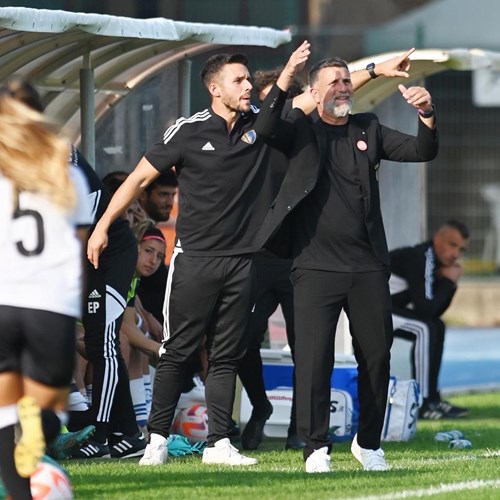Upping your (English) game: lessons learnt
What do the words ‘translation’ and ‘translanguaging’ mean to you? Do they have a place in teaching in your view? Read on to discover where they fitted in an English for football course, what type of language was the focus on the course, how teacher and student co-created knowledge, and how a sense of progress was established. Are there any lessons from their experience you can apply in your own teaching?
In my first blog post on the topic of English for football, I told you the story of my brother, women’s Serie A football coach Marco Bruzzano, and how he started learning English with his teacher Christopher Walker. If you’re interested in what a football coach does, how they use English and how a test-teach-test (TTT) approach worked for Marco and Christopher, do take a look at the previous post. But, if you are curious what’s in the second part, and if you’d like to learn more about the type of language that comes up in such a course, the roles of teacher and student, and how a sense of progression is established, then read on!
Language issues: contextualised grammar, translation, translanguaging
Before meeting Christopher and needing English for football, Marco’s experience with learning the language had been limited to school, plus trying to watch TV and listen to podcasts in English. This made the contrast with Christopher’s methods striking: as he tells me, he noticed straightaway how they didn’t just ‘do grammar’ but rather used the grammar to talk about what he needed for his job.
Christopher gave me more insights into this: as he explained, there is no point in doing decontextualised grammar for Marco’s needs, and in fact, using authentic materials (for, I would add, genuine purposes) provides rich language input. He then gave the example of the present simple as used in football commentary (e.g. ‘she passes the ball; she scores’), noting: ‘if you look at a grammar guide, it may not be apparent that you can use the present simple to describe an action that is happening live – but it is actually done in real life’.

In terms of language, Christopher said they paid special attention to inaccurate word choice, translation mistakes (especially false friends) and register (e.g. finding more polite ways of expressing a thought). Interestingly, translation was a tool that was used in the lessons: Marco had to translate the subtitles of the videos he used with his players, so the first language of the learners (L1) was actively harnessed as a tool in the classroom.
And not just in the classroom: since the Como Women team includes players of different nationalities and now both Italian and English are spoken, translanguaging is also a common occurrence. As Marco told me: ‘in Italian, a key word I’d use often is rifinitura (i.e. putting the finishing touches to a training session). This doesn’t have an exact translation in English, but it doesn’t matter because after using it for a while, I started hearing the English-speaking players use the term themselves!’
The role of the teacher: who is really the expert?
The issue of terminology made it clear that the roles of student and teacher needed to be redefined in this course. Christopher explained: ‘in a few cases, I didn’t know how to translate or explain something because I feel that football is more lexically limited in English than it is in Italian. So, when Marco told me about a particular training drill or position, I became the student – for some lessons, it’s like there wasn’t a teacher: we had a problem (e.g. explaining a drill) and together we created knowledge’.
Indeed, in his article CLIL versus ESP, which he wrote for the latest issue of Modern English Teacher, Christopher reminds us that it is Marco who is the expert in football, and as such, the course is more ESP than CLIL.
Creating a sense of progression
In a course without tests and exams (or even exercises!) how does one get a sense of the progress they are making? In a course with such practical real-life applications, motivation and a sense of progress come from – you guessed it – life itself. As Marco told me: ‘last year, I had an American goalkeeper and I never spoke to her because I didn’t think my English was very good. This season, I have started speaking and my players are like: “Excuse me, when did you start speaking English so fluently?”’
Aside from perceiving his progress, it is also important for Marco (and for any other learner) to be aware of his difficulties and learn to overcome them. This is all part of the construct of metacognition, which includes a learner’s awareness of their difficulties and how to go about overcoming them, including with the use of strategies. Thanks to his course, Marco seemed to have developed his metacognition, as he shared some of his difficulties. For example, during games, he has to substitute players and give the new player directions in no more than 20 seconds. This also includes understanding any questions from them. As he explained, he noticed that he had been better able to manage this over the past few months, but this was a specific task in which he still needed practice to improve.
Photo ©Fabrizio Cusa
His awareness also extended to his use of grammar and his mistakes. As he explained: ‘I’m never sure about my grammar but now I understand that what is important is that the person I’m speaking to understands me. I know sometimes I have to use the -ed form and sometimes I don’t, and I worry I’ll say something wrong, but I think this is normal’. Indeed, when I asked Christopher about his approach to feedback and grammar, he reinforced the meaning-driven nature of their work: ‘if it’s a case of miscommunication, it will have a real-life impact, for example the player might do the wrong thing. This is something we would go over. However, if there are mistakes and they don’t interfere with meaning, it’s okay. We don’t stop at every little thing. That could lead to further fossilisation but it’s not something he needs’.
What are your experiences with ESP? How have you tried to establish a sense of progress in a meaning-driven, conversation-based course? Let us know in the comments section!


Comments
Write a Comment
Comment Submitted